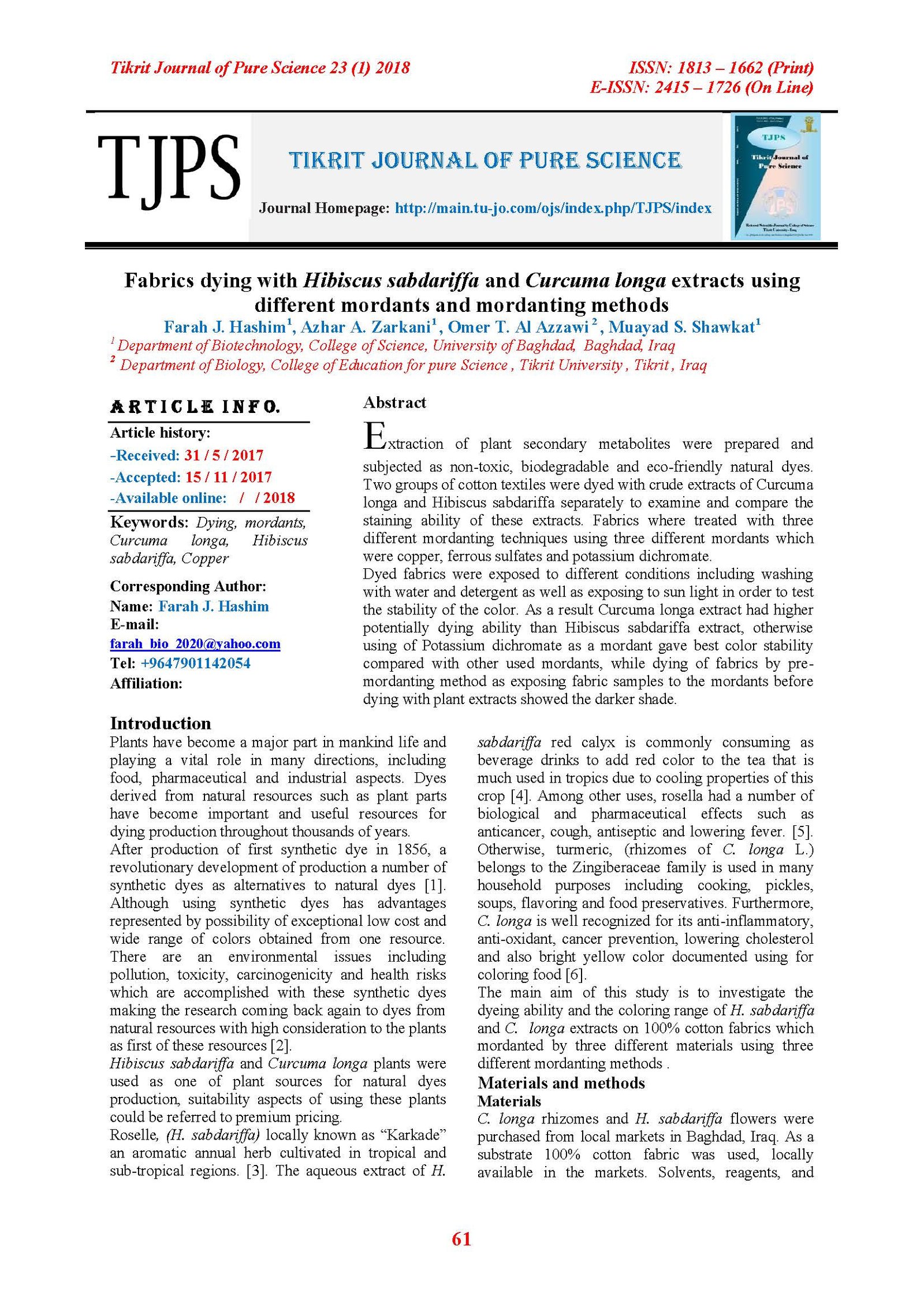Fabrics dying with Hibiscus sabdariffa and Curcuma longa extracts using different mordants and mordanting methods
Main Article Content
Abstract
Extraction of plant secondary metabolites were prepared and subjected as non-toxic, biodegradable and eco-friendly natural dyes. Two groups of cotton textiles were dyed with crude extracts of Curcuma longa and Hibiscus sabdariffa separately to examine and compare the staining ability of these extracts. Fabrics where treated with three different mordanting techniques using three different mordants which were copper, ferrous sulfates and potassium dichromate.
Dyed fabrics were exposed to different conditions including washing with water and detergent as well as exposing to sun light in order to test the stability of the color. As a result Curcuma longa extract had higher potentially dying ability than Hibiscus sabdariffa extract, otherwise using of Potassium dichromate as a mordant gave best color stability compared with other used mordants, while dying of fabrics by pre-mordanting method as exposing fabric samples to the mordants before dying with plant extracts showed the darker shade.
Article Details

This work is licensed under a Creative Commons Attribution 4.0 International License.
Tikrit Journal of Pure Science is licensed under the Creative Commons Attribution 4.0 International License, which allows users to copy, create extracts, abstracts, and new works from the article, alter and revise the article, and make commercial use of the article (including reuse and/or resale of the article by commercial entities), provided the user gives appropriate credit (with a link to the formal publication through the relevant DOI), provides a link to the license, indicates if changes were made, and the licensor is not represented as endorsing the use made of the work. The authors hold the copyright for their published work on the Tikrit J. Pure Sci. website, while Tikrit J. Pure Sci. is responsible for appreciate citation of their work, which is released under CC-BY-4.0, enabling the unrestricted use, distribution, and reproduction of an article in any medium, provided that the original work is properly cited.
References
1- Sujata S. and Raja A. S. M., Textile Science and Clothing Technology, Springer Science +Business Media, Natural Dyes: Sources, Chemistry, Application and Sustainability Issues , Singapore 2014
2- Saini Sangita and Satsangi Preeti, International Journal of Emerging Technology and Advanced Engineering, Sesbania Aculeata: A Plant for Coloring Cotton and Silk Fabric, Vol 4(10), 2014, Pp 141-145.
3- Bahaeldeen Babiker M., Abdelatif Ahmed S. and Abdelhafiz Adam D. , Bull. Environ. Pharmacol. Life Sci., Roselle (Hibiscus sabdariffa L.) in Sudan, Cultivation and Their Uses, Volume 1 [6] May 2012: 48 - 54
4- Izonfuo W-A L; Fekarurhobo, G K; Obomanu, F G; DaworiyeA, J. Appl. Sci. Environ. Mgt., Acid-base indicator properties of dyes from local plants I: Dyes from Basella alba (Indian spinach) and Hibiscus sabdariffa (Zobo), 2006, Vol. 10 (1) 5 - 8
5- Mungole A. and Alka Ch., International Journal of Pharmaceutical Sciences Review and Research, HIBISCUS SABDARIFFA L A RICH SOURCE OF SECONDARY METABOLITES, Volume 6, Issue 1, January – February 2011; Article-018
6- kiran s. and Kapoor VP, indian journal of traditional knowledge, Optimization of extraction and dying condition for traditional turmeric dye , vol 6 (2), 2007, Pp 270-278
7- Charu S., Sangita s. and gupta V. P., Journal of textile and apparel, technology and management, Extraction of natural dye from Sesbania aculeate plant, Vol 7 (4), 2012, Pp 1-13.
8- Charu S., Sangita s. and gupta V. P., Universal Journal of Environmental Research and Technology, A Study on Green Dyeing of Cotton with Ethanolic Extract of Sesbania aculeate, Vol2 (2), 2012, Pp 38-47.
9- adeel shahid, Ijaz A. Bahatti , Afifah kausar and Eman osman, Indian journal of fibre & textile research, Influence of UV radiation on extraction and dying of cotton fabric with curcuma longa, vol (37), 2012, Pp 270- 278. 10- Vankar P. S. and Shukla D. Journal of Applied Polymer Science,Natural Dyeing with Anthocyanins from Hibiscus rosa sinensis Flowers, 2011 Pp: 1-8.
11- Samanta A. K. and Konar A. ,Natural Dyes, Edited by Dr. Emriye Akcakoca Kumbasar, 2011, chapter 3 , Pp (1- 29), india.
12- Ismail Ozlenen erdem and Yildirim Layla, indian journal of fibre & textile research,Almond shell a natural colorant, vol (37), 2012, Pp 358- 363.
13- Wanyama , B.T. Kiremire , P. Ogwok and J.S. Murumu, International Archive of Applied Sciences and Technology, The Effect of Different Mordants on Strength and Stability of Colour Produced from Selected Dye-Yielding Plants in Uganda , P.A.G., Vol 1 [2] 2010: 81 – 92.
